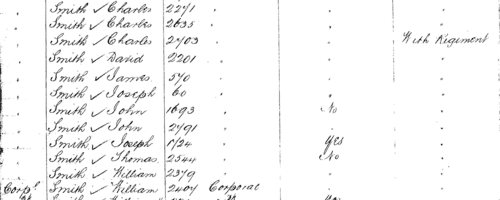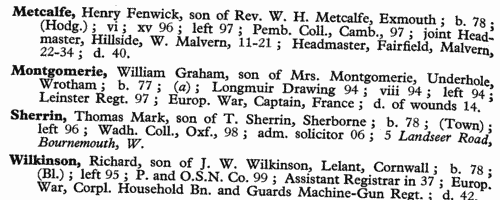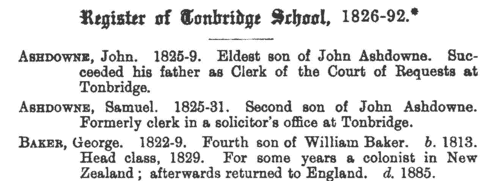Add this eBook to your basket to receive access to all 1,815 records. Our indexes include entries for the spelling hayward. In the period you have requested, we have the following 1,815 records (displaying 1,451 to 1,460): These sample scans are from the original record. You will get scans of the full pages or articles where the surname you searched for has been found. Your web browser may prevent the sample windows from opening; in this case please change your browser settings to allow pop-up windows from this site. Debtors, Insolvents and Bankrupts
(1882)
Bills of sale (binding assets to a creditor/lender), insolvencies and bankruptcies in England and Wales, April to June 1882 | Sample scan, click to enlarge

|  Gordon Highlanders fighting in Egypt
(1882) Gordon Highlanders fighting in Egypt
(1882)
The war medal roll for the Egyptian campaign of 1882 is annotated to show those men actually present at Tel-el-Kebir, and thereby also entitled to the Tel-el-Kebir clasp. In addition, there follows an almost duplicate roll of men entitled to the Bronze Star granted by the Khedive of Egypt in recognition of the campaign. The 1st battalion, The Gordon Highlanders, embarked for Malta in 1881; was transferred to Egypt early in 1882, taking part in the 1882 campaign including the battle of Tel-el-Kebir, and in further fighting in 1884. In 1885 the battalion was moved to Malta, and from thence to Ceylon in 1885. This medal roll relates only to the 1882 campaign; it was compiled in Cairo in November 1882 and the medals were issued 30 January 1883. | Sample scan, click to enlarge

| Partnerships Dissolved
(1882)
Dissolution of trading partnerships, or removal of a partner from a business, in England and Wales | Sample scan, click to enlarge

|  Royal Horse Guards fighting in Egypt
(1882) Royal Horse Guards fighting in Egypt
(1882)
The war medal roll for the Egyptian campaign of 1882 is annotated to show those men actually present at Tel-el-Kebir, and thereby also entitled to the Tel-el-Kebir clasp. In addition, there follows an almost duplicate roll of men entitled to the Bronze Star granted by the Khedive of Egypt in recognition of the campaign. Royal Horse Guards were present at the actions at Kassasin and at the battle of Tel-el-Kebir. This roll was compiled back at Regents Park Barracks in March 1883. | Sample scan, click to enlarge

|  Royal Irish Dragoon Guards fighting in Egypt
(1882) Royal Irish Dragoon Guards fighting in Egypt
(1882)
The war medal roll for the Egyptian campaign of 1882 is annotated to show those men actually present at Tel-el-Kebir, and thereby also entitled to the Tel-el-Kebir clasp. In addition, there follows an almost duplicate roll of men entitled to the Bronze Star granted by the Khedive of Egypt in recognition of the campaign. The 4th (Royal Irish) Dragoon Guards embarked for Egypt in 1882, taking part in the battle of Tel-el-Kebir, and returned to England before the end of the year. This medal roll was compiled at Brighton in November 1882: the medals were issued the following January. | Sample scan, click to enlarge

|  Soldiers of the 1st battalion, South Staffordshire Regiment, fighting in Egypt
(1882) Soldiers of the 1st battalion, South Staffordshire Regiment, fighting in Egypt
(1882)
The war medal roll for the Egyptian campaign of 1882 is annotated to show those men actually present at Tel-el-Kebir, and thereby also entitled to the Tel-el-Kebir clasp. In addition, there follows an almost duplicate roll of men entitled to the Bronze Star granted by the Khedive of Egypt in recognition of the campaign. The 1st battalion, The South Staffordshire Regiment embarked from Ireland to Malta in 1880, and was transferred to Egypt for the 1882 campaign. The battalion was moved back to Malta in 1883, but had to return to Egypt and the Soudan for further fighting in 1884; to Gibraltar in 1886, but back to Egypt in 1891, only returning to England in 1893. However, this roll, which was compiled at Camp Abbasiyeh near Cairo in November 1882, relates only to the 1882 campaign. | Sample scan, click to enlarge

|  Soldiers of the 1st battalion, The Royal Sussex Regiment, fighting in Egypt
(1882) Soldiers of the 1st battalion, The Royal Sussex Regiment, fighting in Egypt
(1882)
The war medal roll for the Egyptian campaign of 1882 is annotated to show those men actually present at Tel-el-Kebir, and thereby also entitled to the Tel-el-Kebir clasp. In addition, there follows an almost duplicate roll of men entitled to the Bronze Star granted by the Khedive of Egypt in recognition of the campaign. The 1st battalion, The Royal Sussex Regiment, embarked for Barbadoes 15 October 1875; was transferred to Malta in 1879; to Cyprus in 1880; and thence to Egypt in 1882. After taking part in the 1882 campaign, the troops were moved south into the Soudan, where they fought in the battle of Abu Klea. This medal roll, compiled at Camp Abbasiyeh near Cairo in November 1882, refers only to the 1882 campaign. The troops returned to England 11 September 1885. | Sample scan, click to enlarge

|  Soldiers of the 1st battalion, West Kent Regiment, fighting in Egypt
(1882) Soldiers of the 1st battalion, West Kent Regiment, fighting in Egypt
(1882)
The war medal roll for the Egyptian campaign of 1882 is annotated to show those men actually present at Tel-el-Kebir, and thereby also entitled to the Tel-el-Kebir clasp. In addition, there follows an almost duplicate roll of men entitled to the Bronze Star granted by the Khedive of Egypt in recognition of the campaign. The 1st battalion, The Queen's Own (Royal West Kent Regiment) embarked for Egypt in 1882, took part in this campaign, and again in the Nile campaign of 1884 to 1885. However, this medal roll, compiled at Polemidia Camp in Cyprus in November 1882, refers only to the 1882 campaign. | Sample scan, click to enlarge

| Boys entering Sherborne School
(1883)
The grammar school at Sherborne in Dorset, which doubtless existed from the creation of the diocese of Sherborne in 705, was refounded by king Edward VI in 1550. At the quatercentenary in 1950, a fourth edition of the Sherborne Register was published, listing boys entering the school during those four centuries. In truth, the materials for this register survive but fitfully before 1823; for some years, no names are known; sometimes all that is known is a surname. But from 1823 onwards the lists and the details get steadily more comprehensive. By the 20th century the boys are listed alphabetically by surname under term of entrance. Surname is given in bold, then christian names, name of father (surname and initials) and address; year of birth; house (a, School House; b, Abbey House; c, The Green; d, Harper House (formerly The Retreat); f, Abbeylands; g, Lyon House; h, Westcott House); whether represented the school at cricket (xi), football (xv), shooting (viii), &c.; year of leaving; summary of degrees, career &c.; and (in italics), address as of 1950. Names in the early lists marked with an asterisk are found inscribed on the oak panelling or on the stone walls of the former schoolroom. (F) in the lists indicates a foundationer, receiving free education: after 1827, when this privilege was restricted to boys from Sherborne and neighbourhood, nearly all foundationers were day-boys. | Sample scan, click to enlarge

| Boys entering Tonbridge School
(1883)
W. O. Hughes-Hughes, late Assistant-Master of Tonbridge School, prepared this edition of the school register. The Kent grammar school was founded by royal charter in 1553, but the surviving register commences with the names of 69 boys called over on Skinners' Day 1826. After that they are arranged alphabetically by quarter to 1833, and thereafter by term of entry. Each entry gives, where known: the boy's surname (in capitals) and full christian name(s); the years when at the school; father's name; year of birth; school honours; and a resume of his subsequent career. | Sample scan, click to enlarge

|
Research your ancestry, family history, genealogy and one-name study by direct access to original records and archives indexed by surname.
|












